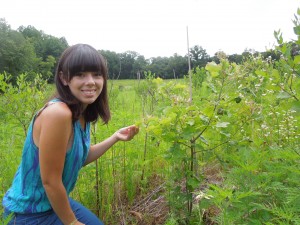by Kristen Minogue
We sprayed pig’s blood on baby trees, studied a strange ménage a trois in the orchid world and met the father of marine invasions science himself. It’s been an odd year at the Smithsonian Environmental Research Center. But we like living in interesting times. Here are 10 of our favorite stories from 2014. Here’s hoping 2015 is even stranger.
The Good
Oysters Have Sidekick in Chesapeake Bay Cleanup
Oysters’ filter-feeding powers have long made them champions for cleaning up the Bay’s murky waters. But a study this spring found they aren’t the only ones that can do the job. Another mollusk can fill in the cracks that oysters often miss.
Urban Kids, Urban Waterways
These high schoolers from southeast DC spent their summer doing field work that could help restore a polluted watershed. We love our citizen scientists.
“The Dream Has Been Fulfilled”
At last. After three years of construction (and two decades of planning), we moved into what’s targeted to be the Smithsonian’s first LEED-Platinum building, the Mathias Laboratory. We’re still enjoying the honeymoon.
The Scary
Dead Zones on the Rise
The world’s waters are warming. This can make for a dangerous cocktail that allows dead zones to expand as climate change marches on, scientists from the Smithsonian Environmental Research Center and the Smithsonian Tropical Research Institute discovered in a paper this fall.
Before it was Cool: The Father of Marine Invasions Biology
Jim Carlton is a hero whom few took seriously–until an invasion of zebra mussels in the 1980s shut off the water supply of 50,000 Michiganders for three days straight. The frightening thing is that our planet still needs so many scientists like him.
Thousands of Tags Could Unearth Clues to Saving Blue Crab
Blue crabs had a rough year, hitting their lowest point since 2008 according to the Winter Dredge Survey. Females felt the brunt of it as they dipped below the safety zone for the first time in more than a decade. This summer and fall, the Fish & Invertebrate Lab set out on a mission to tag 10,000 of the imperiled crabs in search of a way to rescue them.
The Weird
Wintering Wood Frogs Freeze Solid
Who needs the Easter bunny, when you have a frog that can stop its heart–and its lungs–every winter and come back to life in the spring?
Intern Logs: A Bloody Welcome
“Ecological research usually doesn’t evoke thoughts of Stephen King horror movie scenes….However, fellow intern Megan Palmer and I learned on our first week that sometimes, just sometimes, Stephen King references are the best way to describe a day’s work in the field.”
Orchids, Fungi and Bacteria: It’s Complicated
Many orchids couldn’t germinate without fungi–an awkward pairing sometimes likened to Beauty and the Beast. But if that’s not strange enough, it turns out the process may actually be a ménage a trois, with bacteria as the unlikely third player.
Curiouser and Curiouser: A Motor at the Front?
“With its motor located near the bow (front) of the boat, the modern-day mullet skiff could have been a character in Lewis Carroll’s novel “Alice’s Adventures in Wonderland.” Similar to the unpunctual rabbit, vanishing cat and hookah smoking caterpillar, it seems illogical…or does it?”


